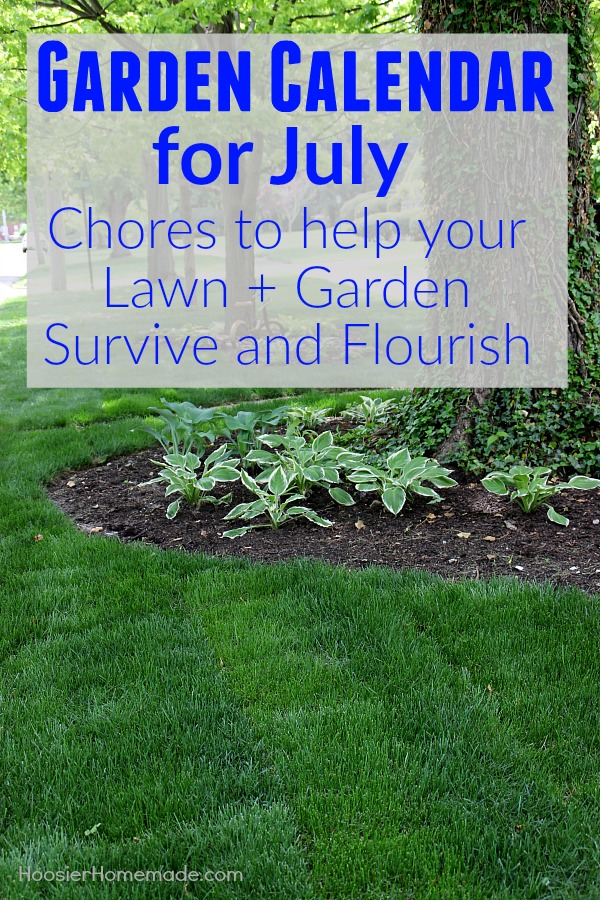Garden Calendar for July

The Garden Calendar for July is packed with “chores” that will make your lawn and garden survive and flourish during the summer heat. These tasks will also set you up for a beautiful fall. Get your gardening gloves ready! Click here for your FREE garden and landscape journal- the first step to gardening success!
I have been taking care of our garden for a long time. And over the years I have made notes to myself of what to do each month. This list is for our Hardiness Zone 5 garden, but many of you will find that the items need to be done no matter where you reside.
I’ll break this into 3 categories, lawn, landscape and garden to help you focus on exactly what you need to be doing.
Lawn
- Watering
Make sure everything is getting enough water, about an inch per week for lawns- more in extreme heat and drought. Water in the early morning to minimize evaporation and use a timer to prevent over-watering if you tend to forget you have the water going like I do. - Raise your mowing height
Make sure you are cutting your grass at least 3”, I will raise my mowing height as high as 3 1/2″ even 4″ during the summer. The little longer grass shades the roots of the grasses to keep them cooler and your soil will retain moisture better. Plus your lawn will require less sprinkling. - Sharpen your mowers’ blades
Your blades have been through the flush growth of spring and are in need of a new edge. Dull blades tear your grass (instead of cutting it), stressing it and making it prone to diseases and insects. - Fertilize the lawn
You should be due to fertilize your lawn. If you are, apply it during the first part if July. Also use this time to look for any dead spots and check them for grubs. A well fertilized lawn will survive heat much better. - A fungus is among us
With the heat and humidity of summer comes increased chances for lawn fungus to develop, especially Powdery Mildew. If you do develop fungus on your lawn, you may need to adjust watering times or amounts to get it under control. - Check for grubs
If dead patches of grass will pull up like a loose piece of sod, you probably have grubs. If the problem is widespread, treat with non toxic milky spore, or grub control chemicals. Don’t worry about a small problem, your lawn should recover with enough water.
Landscape and Flower Beds
-
- Prune hedges
Do not do severe pruning, only light trimming to shape. - Remove suckers
Remove water sprouts and suckers from trees. - Check hanging baskets and window boxes
Hanging baskets and window boxes dry out quickly and need frequent watering. They will also need to be fertilized regularly, at least once a month with a liquid fertilizer. - Divide
Daylilies, bearded iris, and peonies can be divided by end of July, but do it on a cool morning. Mulch and water well. - Deep water trees
Give your trees a deep soaking to get through the summer heat. Make sure the mulch is deep, up to 4 inches deep, and not in contact with the trunk. - Plant zinnias
Zinnia seeds sown the first week of July will give you late bloomers that are frost tolerant. - Deadhead
Remove spent blooms from annuals and perennials, removing seed pods to prevent self seeding.
- Prune hedges
Gardens
-
-
- Harvest
Many of your vegetables will be ready for harvest by now. Beans should be ready this month and tomatoes and peppers should be ready by the middle of the month. - Fertilize vegetables
Fertilize the vegetable gardens every few weeks with a liquid fertilizer, less often with slow release fertilizer. - Watering
Gardens will require 1 t0 1 1/2″ of water per week. Tomatoes must have consistent watering to prevent mis-shapen fruit and blossom end rot. Water early enough in the day to allow plants to dry before nighttime. - Check container gardens
Container gardens dry out quickly and need frequent watering where a container watering system is recommended. They will also need to be fertilized regularly. - Weed
Keep weeding to prevent a weed crop the competes with your plants for water and nutrients. - Don’t apply pesticides
During the summer heat, avoid applying pesticides, even insecticidal soaps. If you must, apply on a cool evening.
- Harvest
-
Whew, that is quite a list! Taking a weekend to do a few of the bigger tasks will knock most of them out! In the mornings, I like to turn on the sprinkler and attend to a few of the smaller tasks, like weeding and fertilizing. A well kept garden is work, but you can enjoy it all year round!



How do fertalize Flower beds after you have laid alayer mulch?
Hey Walter, The best way to fertilize your flower beds after you have mulched is by using a foliar applied fertilizer.